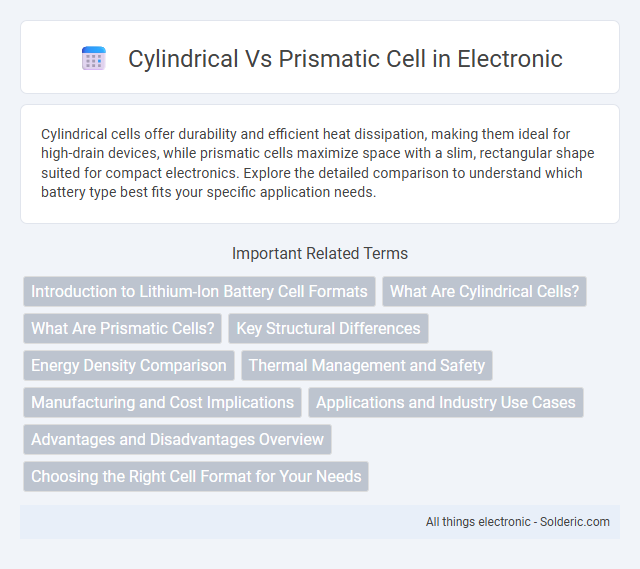Cylindrical cells offer durability and efficient heat dissipation, making them ideal for high-drain devices, while prismatic cells maximize space with a slim, rectangular shape suited for compact electronics. Explore the detailed comparison to understand which battery type best fits your specific application needs.
Comparison Table
| Feature | Cylindrical Cell | Prismatic Cell |
|---|---|---|
| Shape | Round, cylindrical | Rectangular, flat |
| Size Variety | Standardized sizes (18650, 21700) | Customizable size and thickness |
| Energy Density | Moderate | Higher volumetric energy density |
| Cooling Efficiency | Less efficient due to shape | Better heat dissipation, easier cooling |
| Manufacturing Cost | Lower cost, mass production | Higher cost, complex assembly |
| Durability | Strong metal casing, robust | Prone to swelling, requires rigid casing |
| Applications | Power tools, laptops, EVs | Electric vehicles, smartphones, energy storage |
| Weight | Heavier due to casing | Lighter packaging |
| Internal Structure | Spiral-wound electrodes | Stacked or wound electrodes |
Introduction to Lithium-Ion Battery Cell Formats
Lithium-ion battery cells primarily come in cylindrical and prismatic formats, each optimized for specific applications and performance needs. Cylindrical cells feature a spiral-wound design that provides durability and efficient heat dissipation, making them popular in power tools and electric vehicles. Prismatic cells offer a flat, rectangular shape that maximizes space utilization and energy density, ideal for smartphones, laptops, and other compact electronics where design and size constraints are critical.
What Are Cylindrical Cells?
Cylindrical cells are a type of rechargeable battery cell characterized by their uniform, cylindrical shape, commonly used in lithium-ion batteries. These cells feature a spiral-wound electrode design that maximizes surface area, improving energy density and thermal management. Widely utilized in applications like electric vehicles and portable electronics, cylindrical cells offer robust mechanical stability and efficient heat dissipation compared to prismatic cells.
What Are Prismatic Cells?
Prismatic cells are rechargeable battery cells enclosed in a rectangular, flat casing designed to maximize space efficiency in compact devices and electric vehicles. These cells offer higher energy density per volume compared to cylindrical cells, making them ideal for applications requiring slim and lightweight power sources. Your choice of prismatic cells can improve battery pack design flexibility and thermal management due to their flat shape and uniform surface area.
Key Structural Differences
Cylindrical cells feature a round metal casing ideal for efficient heat dissipation and mechanical stability, while prismatic cells use a rectangular, flat packaging that maximizes space utilization within devices. Cylindrical cells generally contain a rolled electrode design, contrasting with the stacked electrode layers found in prismatic cells. These structural differences influence energy density, manufacturing cost, and packaging flexibility in battery applications.
Energy Density Comparison
Cylindrical cells generally offer higher energy density due to their efficient use of space and superior thermal management, making them ideal for applications requiring compact energy storage. Prismatic cells, while often larger and bulkier, provide more flexible packaging options and better volumetric efficiency in certain device designs. Your choice between cylindrical and prismatic cells should consider the specific energy density requirements and form factor constraints of your application.
Thermal Management and Safety
Cylindrical cells feature a metal casing that provides efficient heat dissipation, enhancing thermal management and reducing the risk of overheating during high-drain applications. Prismatic cells, with their flat, rectangular design, offer less surface area for heat dissipation, making thermal management more challenging and requiring advanced cooling systems to ensure safety. Understanding the thermal behavior of each cell type helps optimize Your battery pack design for enhanced safety and performance.
Manufacturing and Cost Implications
Cylindrical cells benefit from well-established automated manufacturing processes, enabling high production volumes and reduced costs per unit, making them cost-effective for applications requiring scalability. Prismatic cells involve more complex assembly with customized casing, leading to higher manufacturing expenses but offering better space utilization and energy density for compact designs. Your choice between these cells should consider the balance between budget constraints and the specific form factor requirements of your battery application.
Applications and Industry Use Cases
Cylindrical cells are widely used in power tools, electric vehicles, and consumer electronics due to their high energy density and robust mechanical design, making them ideal for applications requiring efficient heat dissipation and durability. Prismatic cells find extensive use in electric vehicles and energy storage systems where space optimization and higher capacity per unit volume are critical. Your choice between cylindrical and prismatic cells will depend on specific industry needs such as form factor constraints, energy capacity, and thermal management requirements.
Advantages and Disadvantages Overview
Cylindrical cells offer superior structural stability and efficient heat dissipation, making them ideal for high-drain applications and easier automated manufacturing. Prismatic cells provide higher energy density and better space utilization in compact devices but are more costly to produce and prone to swelling during charge cycles. Both types balance performance and design trade-offs depending on application requirements and thermal management needs.
Choosing the Right Cell Format for Your Needs
Cylindrical cells, known for their robustness and high energy density, are ideal for applications requiring efficient thermal management and mechanical stability, such as power tools and electric vehicles. Prismatic cells offer a compact design with better space utilization and flexibility in shape, making them suitable for consumer electronics and electric vehicles where maximizing battery pack volume is crucial. Selecting between cylindrical and prismatic cells depends on balancing factors like energy density, thermal performance, design constraints, and cost-effectiveness to meet specific application requirements.
Cylindrical vs prismatic cell Infographic

 solderic.com
solderic.com